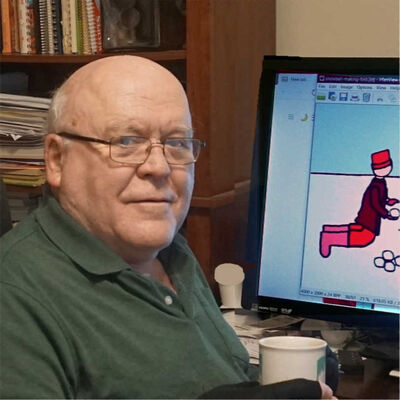A Pause to Reflect on Weights and Measures
Feb 28, 2024 08:52:04 #
Beautiful! Especially the weights. I collected lab balances for a while. Fascinating devices
Thanks
Thanks
Feb 28, 2024 08:53:08 #
Feb 28, 2024 10:31:33 #
Reuss Griffiths
Loc: Ravenna, Ohio
RoswellAlien wrote:
Beautiful! Especially the weights. I collected lab balances for a while. Fascinating devices
Thanks
Thanks
Thanks for looking in and commenting. I agree with you on the weights. The glassware's appeal is it's oddity even for those familiar with chemical glassware. But the weights are all bling. All that glitters is not gold but when it comes to brass, it's pretty close. I collected balances too. Had an old two-pan analytical balance where you just had to watch it swing, make a minor adjustment and watch it swing some more. Gave it to my daughter, also a chemist.
Feb 28, 2024 10:35:22 #
Reuss Griffiths
Loc: Ravenna, Ohio
sippyjug104 wrote:
I've been weighting for this for quite some time.😁
Thanks for looking in Gary. I love a good pun as you can see from my title. Yours is a pretty good one too. 😁😁
Feb 28, 2024 13:35:45 #
Feb 28, 2024 13:38:43 #
Reuss Griffiths
Loc: Ravenna, Ohio
Fredstersphotos wrote:
Cool images! Well done.
I'm glad you liked them and your generous comments. Thanks for looking in.
Feb 28, 2024 15:17:05 #
Reuss Griffiths wrote:
The following still lifes are arrangements of item... (show quote)
 Great shots of rare and interesting items! As they are transparent, what about to take them with rim light? Should render a quite nice result.
Great shots of rare and interesting items! As they are transparent, what about to take them with rim light? Should render a quite nice result.Feb 29, 2024 17:59:26 #
Reuss Griffiths wrote:
Thanks for looking in and the three thumbs up.
These are all nicely done. But to be precise, don't you need to give us the temperature at which they are correct?
 --Richard
--RichardFeb 29, 2024 19:35:05 #
Reuss Griffiths
Loc: Ravenna, Ohio
Dan' de Bourgogne wrote: Great shots of rare and interesting items! As they are transparent, what about to take them with rim light? Should render a quite nice result.
Great shots of rare and interesting items! As they are transparent, what about to take them with rim light? Should render a quite nice result.
 Great shots of rare and interesting items! As they are transparent, what about to take them with rim light? Should render a quite nice result.
Great shots of rare and interesting items! As they are transparent, what about to take them with rim light? Should render a quite nice result.Hadn't occurred to me so I tried it on a very small scale and since the flasks are on a mirror, the only direction to bring the light from is the side. When I tried it, the light from the side brightened up the black backdrop and reduced the light on the flasks themselves. Didn't appeal to me. Hey, everyone has a great idea that won't work. That being said, I'm glad you liked them and were interested enough to suggest the rim lighting. Thanks!
Feb 29, 2024 19:40:59 #
Reuss Griffiths
Loc: Ravenna, Ohio
profbowman wrote:
These are all nicely done. But to be precise, don't you need to give us the temperature at which they are correct?  --Richard
--Richard
 --Richard
--RichardThanks for looking in and your kind comments. Sounds like that profbowman might translate to professor Bowman? And the answer to your question, the proper temperature to measure specific gravity is 20 degrees C ~ 67 F. One fills the flask to full with the cap off the side arm. It is then held in the hand (gloves on) until the temperature rises to 20 C, then the side arm is wiped with a tissue, the cap replaced and weighed on a balance. If the temperature rises, whatever is in the flask stays in contained in the cap. And in the spirit of full disclosure, that's a very un PC pycnometer as it has a mercury thermometer.
Feb 29, 2024 21:29:46 #
Reuss Griffiths wrote:
Thanks for looking in and your kind comments. Sou... (show quote)
Yes, I am a retired professor of physics, s, A. Leroy and Wanda H. Baker Chair of Science, Emeritus. My PhD is in biochemistry and biophysics with two summers' experience in a commercial testing laboratory. So, some of tese pieces of glassware are familiar to me. However, I am a gong-ho opponent against mercury. Even its vapor is dangerous.
As to the temperature of reference often being 20 deg C, the story goes that this came about from labs in Europe not being heated in winter. However, in my time working on my PhD, it was "known" that when one saw a reference temperature of 20 or 18 deg C in the literature, it was probably from a "cold" lab in Israel that was still not heated in winter. How true all of that is and was, I do not know, but it made a good story. Now when I worked on occasion at the synchrotron in Wisconsin, USA, we were definitely kept shirt-sleeved warm from the heat from all the electronics instrumentation in use. --Richard
Feb 29, 2024 21:52:34 #
Reuss Griffiths
Loc: Ravenna, Ohio
profbowman wrote:
Yes, I am a retired professor of physics, s, A. Le... (show quote)
A long time ago in a galaxy far far away, I ran analytical and physical testing laboratories for plastics. The physical testing laboratory had to be 20 C and 50% relative humidity to comply with ASTM requirements. It was way too cool and damp for me so I spent most of my time in the analytical lab. Concerning the thermometer, it's way too expensive ($325) for me to toss out when it will never be used again. Reuss (sounds like Royce, it's German)
If you want to reply, then register here. Registration is free and your account is created instantly, so you can post right away.


